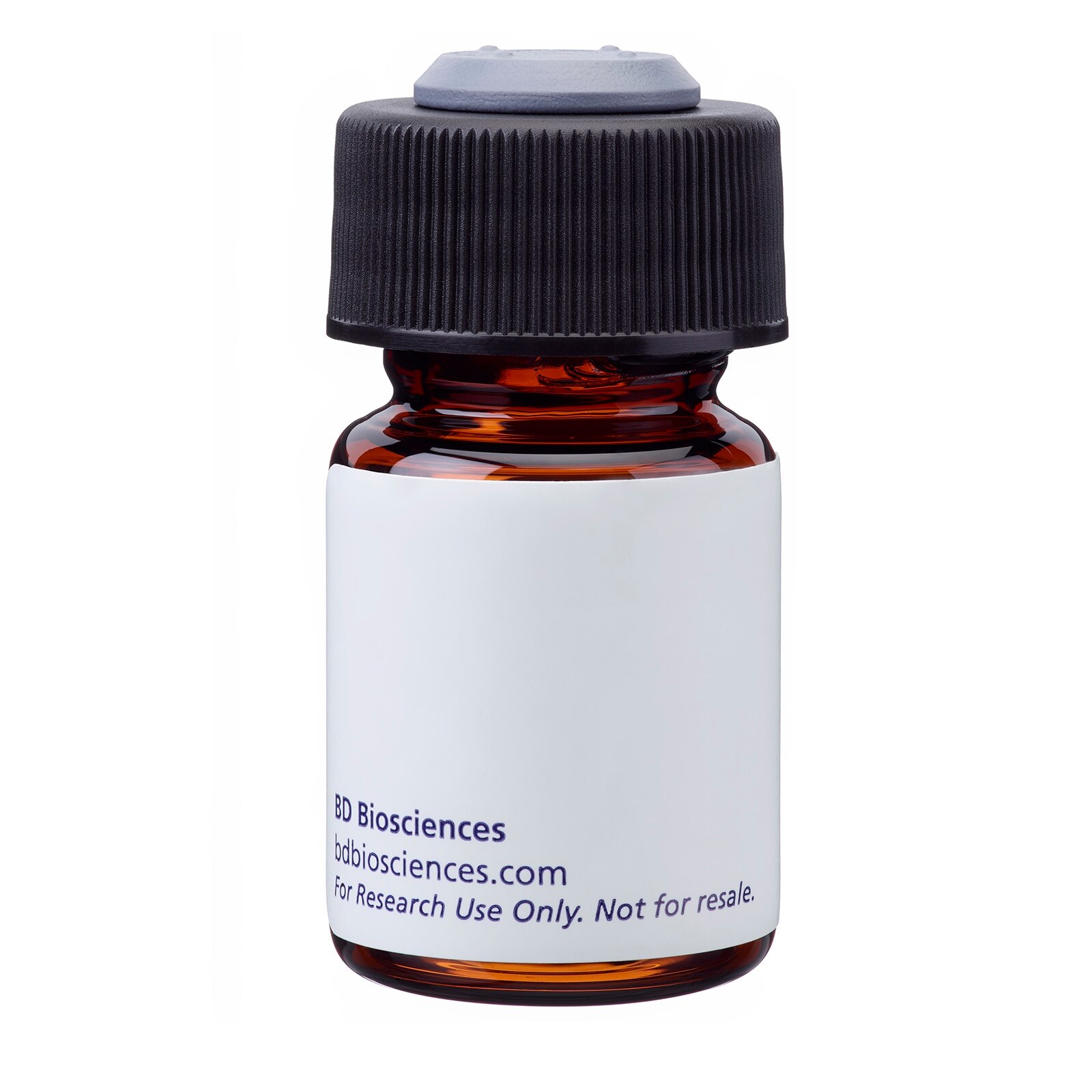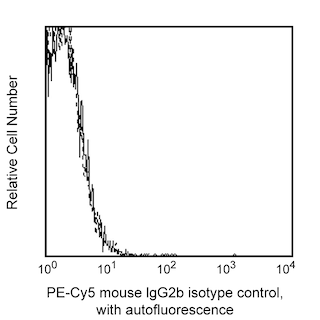Old Browser
Looks like you're visiting us from {countryName}.
Would you like to stay on the current country site or be switched to your country?




Flow cytometric analysis of CD86 expression on Daudi cell line. Daudi cells were stained with either PE-Cy™5 Mouse Anti-Human CD86 (Cat. No. 555666; solid line histogram) or PE-Cy™5 Mouse IgG2b κ Isotype Control (Cat. No. 555744; dashed line histogram). Fluorescent histograms were derived from gated events with the side and forward light-scattering characteristics of viable cells. Flow cytometry was performed on a BD FACScan™ system.


BD Pharmingen™ PE-Cy™5 Mouse Anti-Human CD86

Regulatory Status Legend
Any use of products other than the permitted use without the express written authorization of Becton, Dickinson and Company is strictly prohibited.
Preparation And Storage
Product Notices
- This reagent has been pre-diluted for use at the recommended Volume per Test. We typically use 1 × 10^6 cells in a 100-µl experimental sample (a test).
- An isotype control should be used at the same concentration as the antibody of interest.
- Source of all serum proteins is from USDA inspected abattoirs located in the United States.
- Caution: Sodium azide yields highly toxic hydrazoic acid under acidic conditions. Dilute azide compounds in running water before discarding to avoid accumulation of potentially explosive deposits in plumbing.
- PE-Cy5 is optimized for use with a single argon ion laser emitting 488-nm light. Because of the broad absorption spectrum of the PE-Cy5 tandem fluorochrome, extra care must be taken when using dual-laser cytometers which may directly excite both PE and Cy5™.
- PE-Cy5 tandem fluorochromes have been reported to bind some classes of human macrophages and granulocytes via Fc receptors, and PE has been reported to bind to mouse B lymphocytes via Fc receptors. Preincubation of mouse leukocytes with Mouse BD Fc Block™ purified anti-mouse CD16/CD32 mAb 2.4G2 can reduce the non-specific binding of PE-Cy5-conjugated reagents to mouse B cells. However, PE-Cy5 conjugated reagents should not be used to stain splenocytes of SJL, NOD, and MRL mice as B lymphocytes and/or other leukocytes have been reported to non-specifically stain regardless of the use of Mouse BD Fc Block™ (the CD72c complex has been implicated for PE-Cy5 binding in these strains). Reagents conjugated to PE, PerCP, PerCP-Cy5.5, APC, and APC-Cy7 tandem fluorochrome can be used on leukocytes from these mouse strains.
- PE-Cy5 is a tandem fluorochrome composed of R-phycoerythrin (PE), which is excited by the 488 nm light of an Argon ion laser and serves as an energy donor, coupled to the cyanine dye Cy5, which acts as an energy acceptor and fluoresces at 670 nm. BD Biosciences Pharmingen has maximized the fluorochrome energy transfer in PE-Cy5, thus maximizing its fluorescence emission intensity, minimizing residual emission from PE, and minimizing lot-to-lot variation.
- Cy is a trademark of GE Healthcare.
- Please refer to www.bdbiosciences.com/us/s/resources for technical protocols.
Companion Products



The IT2.2 monoclonal antibody specifically binds to CD86. CD86 is a ~ 75 kDa type I transmembrane glycoprotein which is also known as B7-2 or B70. CD86 is primarily expressed on monocytes, dendritic cells, Langerhans cells, and activated B cells including B lymphoid cells in germinal centers and Epstein-Barr virus transformed B-cell lines. CD86 is a ligand for CD28 and CD152 (CTLA-4) and may play an important role in costimulation of T cells in primary immune responses. Competitive binding assays demonstrate that, while both the IT2.2 and FUN-1 monoclonal antibodies recognize the same CD86 molecule, they react with different epitopes. IT2.2 blocks the costimulation activity of CD86 in functional studies and blocks binding of human CTLA-4-Ig fusion protein to CD86 gene-transfected cells.

Development References (5)
-
Azuma M, Ito D, Yagita H, et al. B70 antigen is a second ligand for CTLA-4 and CD28.. Nature. 1993; 366(6450):76-9. (Biology). View Reference
-
Engel P, Gribben JG, Freeman GJ, et al. The B7-2 (B70) costimulatory molecule expressed by monocytes and activated B lymphocytes is the CD86 differentiation antigen. Blood. 1994; 84(5):1402-1407. (Biology). View Reference
-
Engel P, Wagner N, Tedder TF. CD86 Workshop Report. In: Schlossman SF. Stuart F. Schlossman .. et al., ed. Leucocyte typing V : white cell differentiation antigens : proceedings of the fifth international workshop and conference held in Boston, USA, 3-7 November, 1993. Oxford: Oxford University Press; 1995:703-705.
-
Hardie DL, Casamayor M, Johnson GD, et al. CD86 Workshop Panel report. In: Kishimoto T. Tadamitsu Kishimoto .. et al., ed. Leucocyte typing VI : white cell differentiation antigens : proceedings of the sixth international workshop and conference held in Kobe, Japan, 10-14 November 1996. New York: Garland Pub.; 1997:201-204.
-
Nozawa Y, Wachi E, Tominaga K, Abe M, Wakasa H. A novel monoclonal antibody (FUN-1) identifies an activation antigen in cells of the B-cell lineage and Reed-Sternberg cells. J Pathol. 1993; 169(3):309-315. (Biology). View Reference
Please refer to Support Documents for Quality Certificates
Global - Refer to manufacturer's instructions for use and related User Manuals and Technical data sheets before using this products as described
Comparisons, where applicable, are made against older BD Technology, manual methods or are general performance claims. Comparisons are not made against non-BD technologies, unless otherwise noted.
For Research Use Only. Not for use in diagnostic or therapeutic procedures.
Refer to manufacturer's instructions for use and related User Manuals and Technical Data Sheets before using this product as described.
Comparisons, where applicable, are made against older BD technology, manual methods or are general performance claims. Comparisons are not made against non-BD technologies, unless otherwise noted.